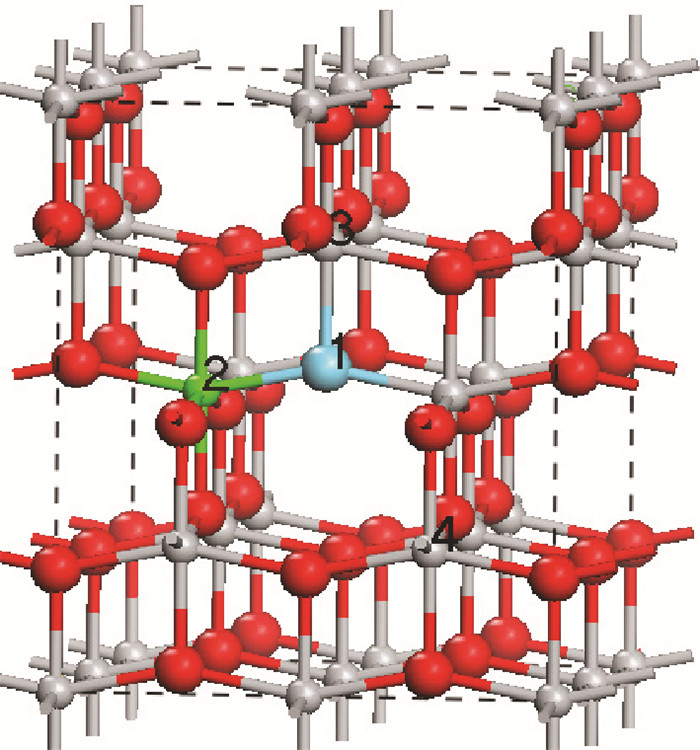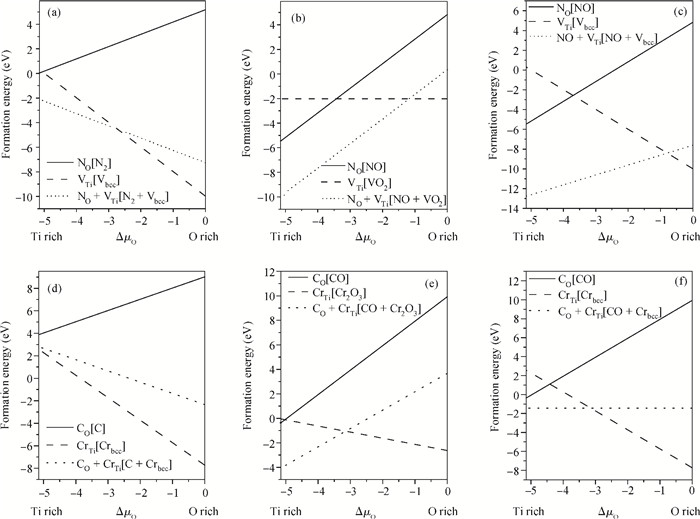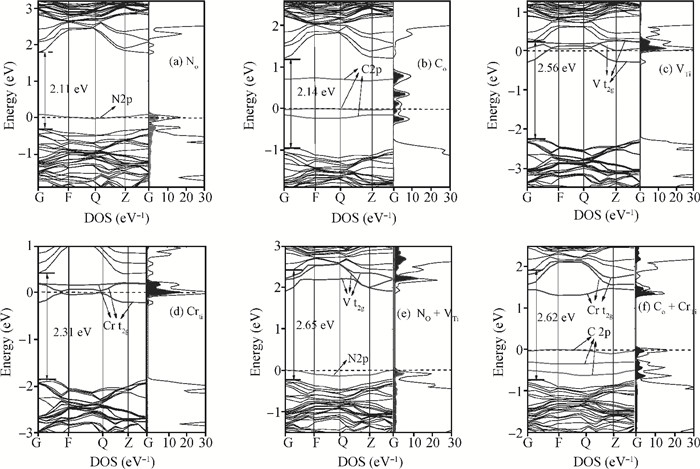| Citation: |
Wenhui Xu, Xinguo Ma, Tong Wu, Zhiqi He, Huihu Wang, Chuyun Huang. First-principles study on the synergistic effects of codoped anatase TiO2 photocatalysts codoped with N/V or C/Cr[J]. Journal of Semiconductors, 2014, 35(10): 102002. doi: 10.1088/1674-4926/35/10/102002
****
W H Xu, X G Ma, T Wu, Z Q He, H H Wang, C Y Huang. First-principles study on the synergistic effects of codoped anatase TiO2 photocatalysts codoped with N/V or C/Cr[J]. J. Semicond., 2014, 35(10): 102002. doi: 10.1088/1674-4926/35/10/102002.
|
First-principles study on the synergistic effects of codoped anatase TiO2 photocatalysts codoped with N/V or C/Cr
DOI: 10.1088/1674-4926/35/10/102002
More Information
-
Abstract
An effective compensated codoping approach is described to modify the photoelectrochemical properties of anatase TiO2 by doping with nonmetals (N or C) and transition metals (V or Cr) impurities. Here, compensated codoped TiO2 systems are constructed with different dopant species and sources, and then their dopant formation energies and electronic structures are performed to study the stability and visible-light photoactivity by first-principles plane-wave ultrasoft pseudopotential calculations, respectively. The calculated results demonstrate that the codoping with transition metals facilitates the enhancement of the concentration of p-type dopants (N and C) in a host lattice. Especially, compensated codoping not only reduces the energy gap, to enhance the optical absorption, and eliminate the local trapping, to improve carrier mobility and conversion efficiency, but it also keeps the oxidation-reduction potential of the conduction band edge. These results are conducive to the understanding of the synergistic mechanism of the photocatalytic activity of TiO2 that is enhanced by codoping.-
Keywords:
- first-principles,
- photocatalysis,
- TiO2,
- codoping
-
References
[1] Chen X B, Shen S H, Guo L J, et al. Semiconductor-based photocatalytic hydrogen generation. Chem Rev, 2010, 110:6503 doi: 10.1021/cr1001645[2] Kudo A, Mesiki Y. Heterogeneous photocatalyst materials for water splitting. Chem Soc Rev, 2009, 38:253 doi: 10.1039/B800489G[3] Huang S Y, Schlichthorl G, Nozik A J, et al. Charge recombination in dye-sensitized nanocrystalline TiO2 solar cells. J Phys Chem B, 1997, 101:2576 doi: 10.1021/jp962377q[4] Wang P, Zakeeruddin S M, Moser J E, et al. A stable quasi-solid-state dye-sensitized solar cell with an amphiphilic ruthenium sensitizer and polymer gel electrolyte. Nat Mater, 2003, 2:402 doi: 10.1038/nmat904[5] Joshi M M, Labhsetwar N K, Mangrulkar P A et al. Visible light induced photoreduction of methyl orange by N-doped mesoporous titania. Appl Catal A, 2009, 357:26 doi: 10.1016/j.apcata.2008.12.030[6] Valentin C D, Pacchioni G, Selloni A. Theory of carbon doping of titanium dioxide. Chem Mater, 2005, 17:6656 doi: 10.1021/cm051921h[7] Liu S X, Chen X Y. Activated carbon with excellent chromium (VI) adsorption performance prepared by acid-base surface modification. J Hazard Mater, 2008, 152:48 doi: 10.1016/j.jhazmat.2007.06.062[8] Li X, Xiong R C, Wei G. Preparation and photocatalytic activity of nanoglued Sn-doped TiO2. J Hazard Mater, 2009, 164:587 doi: 10.1016/j.jhazmat.2008.08.069[9] Ozaki H, Iwamoto S, Inoue M. promotive effect of iron on visible-light-induced photocatalytic activities of nitrogen-and silicon-codoped titanias. J Phys Chem C, 2007, 111:17061 doi: 10.1021/jp0751211[10] Li H, Zhao G L, Liu Q H, et al. Influence of silicon doping and silicon-vanadium co-doping on photocatalyst property of TiO2 thin films. J Chin Ceram Soc. 2005, 33:784[11] Ahn K S, Yan Y, Shet S, et al. Enhanced photoelectrochemical responses of ZnO films through Ga and N codoping. Appl Phys Lett, 2007, 91:231909 doi: 10.1063/1.2822440[12] Zhang H, Tan K, Zheng H, et al. Preparation, characterization and photocatalytic activity of TiO2 codoped with yttrium and nitrogen. Mater Chem Phys, 2011, 125:156 doi: 10.1016/j.matchemphys.2010.08.087[13] Zhoa Y Y, Wang J Y, Xu J B, et al. Metal dopants in HfO2-based RRAM:first principle study. Journal of Semiconductors, 2014, 35(4):042002 doi: 10.1088/1674-4926/35/4/042002[14] Zhao Z Y, Liu Q J, Zhang J, et al. First-principles study of 3d transition metal-doped anatase. Acta Phys Sin, 2007, 56:6592 http://wulixb.iphy.ac.cn/EN/Y2007/V56/I11/6592[15] Gai Y Q, Li J B, Li S S, et al. Design of narrow-gap TiO2:A passivated codoping approach for enhanced photoelectrochemical activity. Phys Rev Lett, 2009, 102:036402 doi: 10.1103/PhysRevLett.102.036402[16] Gu D E, Yang B C, Hu Y D. V and N co-doped nanocrystal anatase TiO2 photocatalysts with enhanced photocatalytic activity under visible light irradiation. Catal Commun, 2008, 9:1472 doi: 10.1016/j.catcom.2007.12.014[17] Ma X G, Miao L, Bie S W, et al. Synergistic effect of V/N-codoped anatase TiO2 photocatalysts. Solid State Commun, 2010, 150:689 doi: 10.1016/j.ssc.2009.11.037[18] Meng Q S, Wang T, Liu E Z, et al. Understanding electronic and optical properties of anatase TiO2 photocatalysts co-doped with nitrogen and transition metals. Phys Chem, 2013, 15:9549 doi: 10.1021/jp0756350[19] Vanderbilt D. Ultrasoft pseudopotentials in a generalized eigenvalue formalism. Phys Rev B, 1990, 41:7892 doi: 10.1103/PhysRevB.41.7892[20] Segall M D, Lindan Philip J D, Probert M J, et al. First-principles simulation:ideas, illustrations and the CASTEP code. J Phys:Condens Matter, 2002, 14:2717 doi: 10.1088/0953-8984/14/11/301[21] Perdew J P, Chevary J A, Vosko S H, et al. Applications of the generalized gradient approximation for exchange and correlation. Phys Rev B, 1992, 46:6671 doi: 10.1103/PhysRevB.46.6671[22] Burdett J K, Hughbanks T, Miller G J, et al. Structural-electronic relationships in inorganic solids:powder neutron diffraction studies of the rutile and anatase polymorphs of titanium dioxide at 15 and 295 K. Chem Soc, 1987, 109:3639 doi: 10.1021/ja00246a021[23] Perdew J P, Burke K, Ernzerhof M. Generalized gradient approximation made simple. Phys Rev Lett, 1996, 77:3865 doi: 10.1103/PhysRevLett.77.3865[24] Hammer B, Hansen L B, Norskov J K. Improved adsorption energetics within density-functional theory using revised Perdew-Burke-Ernzerhof functionals. Phys Rev B, 1999, 59:7413 doi: 10.1103/PhysRevB.59.7413[25] Ma X G, Jiang J J, Liang P. Theoretical study of native point defects on anatase TiO2 (101) surface. Acta Phys Sin, 2008, 57:3120 doi: 10.1021/jp9088047?src=recsys[26] Irie H, Watanabe Y, Hashimoto K. Carbon-doped anatase TiO2 powders as a visible-light sensitive photocatalyst. J Phys Chem B, 2003, 107:5483 doi: 10.1021/jp030133h[27] Shankar K, Tep K C, Mor G K, et al. An electrochemical strategy to incorporate nitrogen in nanostructured TiO2 thin films:modification of bandgap and photoelectrochemical properties. J Phys D, 2006, 39:2361 doi: 10.1088/0022-3727/39/11/008[28] Gajbhiye N S, Ningthoujam R S. Low temperature synthesis, crystal structure and thermal stability studies of nanocrystalline VN particles. Mater Res Bull, 2006, 41:1612 doi: 10.1016/j.materresbull.2006.02.036[29] Zhao Z Y, Zhou D C, Yi J. Analysis of the electronic structures of 3d transistion metals doped CuGaS2 based on DFT calculations. Journal of Semiconductors, 2014, 25(1):013002 http://www.jos.ac.cn/bdtxbcn/ch/reader/view_abstract.aspx?file_no=13053002&flag=1[30] Sato J, Kobayashi H, Inoue Y. Photocatalytic activity for water decomposition of indates with octahedrally coordinated d10 configuration. Ⅱ. Roles of geometric and electronic structures. J Phys Chem B, 2003, 107:7970 doi: 10.1021/jp030021q[31] Pan D A, Zhao C D, Zheng Z X. Structure of matter. Beijing:Higher Education Press, 1989 doi: 10.1119/1.1971196[32] Ye L X. Semiconductor physics. Part One. 2nd ed. Beijing: Higher Education Press, 2007[33] Yang Y, Feng Q, Wang W H, et al. First-principle study on the electronic and optical propenties of the anatase TiO2(101) surface. Journal of Semiconductors, 2013, 34(7):073004 doi: 10.1088/1674-4926/34/7/073004 -
Proportional views






 DownLoad:
DownLoad:

















